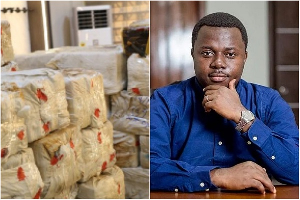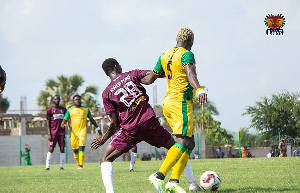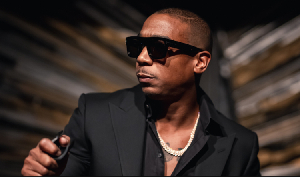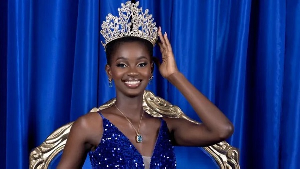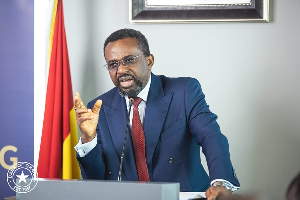The final position of the Abudu Family on the peace process (Jan. 15, 2009) is yet another example of the manipulation of the peace process, by some Dagomba elite of both families. Their selective use of historical facts and events, tradition, custom and the legal system in the narratives they create betray their political and power agenda or project. They hide behind tradition and custom to manipulate, stall and destabilize the peace process. They are the modern day “supporters” of the Namship (the equivalent of political lobbyists here in Washington DC). They are the ones behind the curtains, keeping the curtains of tradition and custom in place.
When there is a political and power agenda, facts, and events are open to interpretation. Parties freely pick and choose what to present as facts, tradition and custom. What the committee of eminent chiefs need to do is find the powerful voices that dominate definitions of Dagomba Custom. They should look behind the curtain to see who else is there, and to reveal the mechanisms used to keep the curtain of tradition and custom in place. Who is saying these traditions are non-negotiable? Who is benefiting from the assertion that they are non-negotiable? Where is the resistance to change located and why. Whose interest is served when inflexibility is invoked?
Customs and traditions change all the time and if there is one traditional system that has changed greatly it is the Dagomba Traditional System. Beginning with the young educated princes, especially grandsons of Ya Na trying to change the system so that grand sons of Ya Nas would qualify to contest. Putting in place a selection committee to replace the customary system of election of a Ya Na. Using secret ballot instead of divination to elect a Ya Na. A sitting Regent tempering with the constitution, ignoring the traditional mediator, the Mamprussi King, and using government and the law courts, the list goes on.
Over the years, Dagomba traditional system has demonstrated an incredible capacity to adapt its customs and traditions. If today those customs and traditions are fixed and unchangeable, then we have the obligation to ask the question; who is benefiting from all this? Customs and traditions are only fixed, eternal, and the true version of the way things are when they are going to effectively legitimize, support and reinforce a call to action. Creating the impression that Dagbon has or had a solid well defined customary system of succession, burials and funerals for their kings and to hold up the peace process because of contentious customary practices is sad. The traditions we have used to punish our enemies and deny them certain privileges has come back to hunt us. As the Chinese proverb goes, “whoever opts for revenge must dig two graves”.
The 1948 Selection Committee: Dagomba custom has it that only the sons of a Ya Na can become a Ya Na. This created a “surplus” of princes struggling for chieftaincy positions in the kingdom. Then there are the educated princes and grandsons of Ya Nas interested in becoming Ya Nas. Who becomes what chief is a matter of negotiation and "political" influence. Having a Ya Na from your side helps. The idea was in circulation in the 1930s, that the traditional system of selecting a Ya Na needed some “upgrading”. In 1948, a selection committee was actually formed (legitimacy?). In 1953, Naa Mahamadu Abudulai whose funeral celebration is the bone of contention presided over a Dagomba State Council meeting as a regent (Gbong-Lana) and acting president of the Council. In the meeting it was unanimously agreed that a Gbong- Lana could contest the Ya Na’s skin. The Demon-Na pointed out that each reigning Gbong-Lana at Yendi had the right to apply for the Yendi Skin though this right had never been written down in the Dagomba Constitution…It was unanimously agreed that the reigning Gbong-Lana had the right to apply for the Yendi Skin and, on the occasions when he did apply, there would be four candidates for the Selection Committee to consider instead of the usual three. It was also unanimously agreed that the right of the Gbong-Lana to apply for the Yendi Skin should be written into the constitution”. In that meeting “it was unanimously agreed that the Resolution made in 1948 regarding the composition of the Selection Committee for the new Ya-Na should continue to stand; and that the Constitution should be amended accordingly” Tradition or custom not withstanding, the ethics of the whole enterprise was suspect.
Naa Yakubu Andani II (then Mion-lana) was present and did not raise any objection. Why did he not raise any objection? Could it be because of the practice that a Gbong-lana could always make such a claim, the understanding being that he took the vacant gate skin since the Ya Na had to come from the gate skin? Could that be the reason why the chiefs clearly stated that the Gbong-lana’s position was not a fourth gate? In that meeting Kpating-Lana’s application to be considered as the four gate was rejected by an 18 to 6 votes to maintain three gates and not four. (Minutes of the second meeting of the Dagomba State Council, December 11/12, 1953).
Shorting after the meeting there was a “rumor that the Selection Committee of 1948 were determined to override the traditional body of King-makers and to make the Gbong-lana Abudulai the Ya-Na?” Who started the rumour? was it a rumor? The Mion-Lana protested to the governor against the two decisions (elegibility of the Gbong-lana and the selection committee), but his protest was dismissed. On March 19, 1954, the Selection Committee of 1948 and 1953, by a majority vote (custom?), selected the Gbon-lana Abudulai as the Ya-Na. Minutes of the meeting are available. The details of the meeting betray a very malleable council of elders. At this meeting it was revealed that the Kuga-Na had (without due consultation) selected the mion-lana as Ya- Na. He had actually been “captured” and brought to Yendi, but was prevented by the Army and police from being enskinned. With police protection, Naa Abudulai of the Abudu family was enskined as Ya-Na, after his father who had just died as Ya-Na.
There is no question that Naa Mahamadu Abudulai was a Ya-Na. Naa Yakuba Andani II himself recognized him and promised the Prime Minister, Dr. Nkrumah, to work with him.
There is also no question that the Andanis were deeply hurt by this whole arrange. To get that close to the Namship and to loose it, is for a Dagomba Prince a very serious matter. A part from this traditional maneuver, Naa Mahamadu Abudulai and his supporters made a political maneuver by “crossing carpet” and joining the CPP camp for fear of deskinment. This way government had no choice but to support him as Ya Na. Naa Yakubu Andani II, after he failed to get the government to diskin Naa Abudulai, had no choice but to accept the government negotiated settlement of the L.I. 59 in which he was to succeed Naa Abudulai and a second Andani family to succeed him as Ya- Na (to balance the Abudu-Abudu succession) before the Abudus will get their turn. A second blow to Naa Yakubu Andani II came, when the Abudu Family succeeded to overturn the L.I. 59. Why is this part of the story absent in the Abudu Family elite supporters’ Narratives? Why are they presenting the L.I. 59 as such a bad thing when it kept Naa Abudulai in power for sometime? If it was truly against tradition and custom, how come no one stood up to Dr. Nkrumah from the Abudu Family?
On the Andani family side, they tried to use their presence in the CPP government in the person of Mr. Alhassani to diskin the Naa Mahamadu Abudulai. Dr. Nkrumah consulted the northern chiefs who all advised him not to diskin the Ya Na, hence the L.I. 59. Mr. Alhassani paid a political prize because Dr. Nkrumah felt misled. To blame government for the L.I. 59 is disingenuous to say the least.
When the national politics favored the Andani Family, Naa Abudulia was deskinned and Naa Yakubu Andani became Ya Na Yakubu Andani II and the Andani Family elite revenge machine set in. Why did the Andani family refuse to accord Naa Mahamadu Abudulai, the appropriate burial rites? If the tradition did not foresee the Ya Na dying in “exile” why could they not still accord him a king’s burial. On what basis are the Andanis denying that he was a Ya Na? Was it the Dagomba State Council that diskinned Naa Mahamadu? Since when did a political intervention constitute a basis for traditional action? Why did government have to force the Andani family to do the right thing? Why was Naa Mahamadu Abudulai’s son not given the opportunity to celebrate his father’s funeral, when the consequences of a Ya Na's son not celebrating his father's funeral are known? If Andanis were badly wronged, why did they not set the records straight in the 27 years of Naa Andani’s reign? What about land sale and appointment of chiefs to certain skins? These kings from both families were not acting in consultation with their elders in the palace. Who were behind the curtains? Who is the victim? Why is this part of the story absent in the Andani Family Elite Narratives?
When brothers cannot find it in their hearts to forgive each other, not only are innocent lives lost, but the very fiber of their society and existence fades away. This is what is happening to Dagbon and the earlier the situation is dealt with the better for Dagbon in particular and the north in general.
Clement M. Aapengnuo,
Conflict Analyst,
Institute for Conflict Analysis and Resolution
George Mason University VA
Opinions of Monday, 25 January 2010
Columnist: Aapengnuo, Clement


